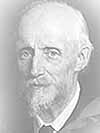Osborne Reynolds
claimed by Charlene Walton (cwalton8) 12.05.2015
Osborne Reynolds (August 23 1842 – February 23 1912) was the pioneer and main contributor of fundamental fluid dynamics. His scientific research on flow contributed to the Reynolds number, Reynolds analogy, Naiver-Stokes equation, Reynolds stress and Reynolds decomposition in order to predict the speed and mass of fluids at a given period of time.

Personal Life
Early Life
Osborne Reynolds was born in Belfast, Ireland to Osborne Reynolds Sr. He followed the footsteps of his father and attended Queen's college and graduated in 1867 as the seventh wrangler in mathematics. He soon after worked in London with Lawson and Masergy but focused more on his academic research and teaching a year later when he was elected the first professor of engineering at Owen's College. During his first years as a chair, Osborne career began rocky. During his time as chair, Osborne marries Charlotte Jemima Chadwick, who, unfortunately dies from peritonitis during child birth. After her death, Osborne steps down as chair and focuses more on his teaching, research and his newly born son. During his initial years as a teacher, Osborne was forced to focus on "out of door" physics (i.e. tails of comets, solar corona,electric properties of clouds), since he did not have a physics research lab available to him to conduct research. This initial focus on "out of door" sparked his interest in fluid dynamics and hydrostatics. His focuses shifted from calculating and observing tails of comets to formation of raindrops and understanding how tree trunks burst after being struck by lighting. His observational studies had lead to the formation of his first significant study on the link between friction and heat transfer. His interest progressed on fluids and flow centered around surface waves deep in the ocean and fluid pipes used in machinery.
Scientific Career
Final Years
Scientific Contributions
What are the mathematical equations that allow us to model this topic. For example [math]\displaystyle{ {\frac{d\vec{p}}{dt}}_{system} = \vec{F}_{net} }[/math] where p is the momentum of the system and F is the net force from the surroundings.
Mathematical Equations & Examples
How do we visualize or predict using this topic. Consider embedding some vpython code here Teach hands-on with GlowScript
Connectedness
- How is this topic connected to something that you are interested in?
- How is it connected to your major?
- Is there an interesting industrial application?
Historical Context and Other Information
Put this idea in historical context. Give the reader the Who, What, When, Where, and Why.
See also
Further reading
Gresham, R.M. "So who was this Osborne Reynolds guy, anyway?" Tribology and Lubrication Technology, September 2014, 70(9):22-23.
External links
https://en.wikipedia.org/wiki/Osborne_Reynolds
https://en.wikipedia.org/wiki/Fluid_dynamics
https://www.youtube.com/watch?v=Wa-RSKv7SRU&list=PL0jAiXLfdUJBAoYmevhgcao62CBX9fIlF&index=2
http://www-groups.dcs.st-and.ac.uk/history/Biographies/Reynolds.html
http://www.britannica.com/biography/Osborne-Reynolds
References
https://en.wikipedia.org/wiki/Osborne_Reynolds
https://www.youtube.com/watch?v=Wa-RSKv7SRU&list=PL0jAiXLfdUJBAoYmevhgcao62CBX9fIlF&index=2
http://www-groups.dcs.st-and.ac.uk/history/Biographies/Reynolds.html